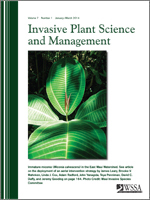Aquarium release is a vector for introducing nonnative species that threatens the ecological integrity of aquatic systems. Following coastal invasions by released aquarium strains of Caulerpa taxifolia, aquarists began using the macroalgal genus Chaetomorpha. Use of Chaetomorpha now exceeds 50% of U.S. aquarium hobbyists we surveyed. Aquarium strains of this macroalgal genus possess broad environmental tolerances, demonstrate high nutrient uptake and growth rates, and reproduce by fragmentation. Although these characteristics make Chaetomorpha a desirable aquarium inhabitant, they may also promote invasive tendencies if the alga is introduced into a natural ecosystem. We sought to proactively mitigate this potential invasion risk by testing algal disposal techniques that serve as responsible alternatives to releasing viable individuals. We tested methods used by aquarium hobbyists—boiling, microwaving, freezing, desiccation, and exposure to freshwater. We determined the minimum durations that these techniques must be used in order to induce mortality in three aquarium purchases of Chaetomorpha. We found that boiling for at least 1 min, microwaving for at least 15 s, or freezing for at least 24 h were sufficient to induce 100% mortality in 1-cm-long fragments and clumps up to 1.5 g. Desiccation required more than 24 h when exposed to air and 6 d for samples kept in closed containers. Freshwater exposure was effective at 6 d. These results indicate that disposal of excess or unwanted Chaetomorpha via garbage (if destined for a landfill) or indoor plumbing (e.g., sinks and toilets) represent safe alternatives to release. Disposal of algal tissue, shipping water, or tank water containing small algal fragments down stormwater drains, however, could introduce this hardy species into favorable conditions that could result in detrimental biological invasions.
Management Implications: Dumping of aquarium contents or used tank water into natural waterways can introduce live organisms that are not native to these environments. This activity has led to numerous aquatic invasions, the most notable of which have been those of Caulerpa taxifolia in several locations around the globe. At present, the most commonly used macroalga by U.S. aquarium hobbyists is the genus Chaetomorpha. With its popularity among hobbyists, the opportunity for its introduction is considerable. In order to mitigate this potential invasion risk, we present here disposal mechanisms for aquarium algae as safe alternatives to release. Minimum durations necessary to ensure algal mortality are listed for aquarium strains of Chaetomorpha through treatment by boiling, microwaving, freezing, desiccation, and exposure to freshwater. Boiling for 1 min or microwaving for 15 s, as well as freezing for 24 h, are sufficient for fragments and clumps of Chaetomorpha up to 1.5 g. Desiccation can take more than 24 h for larger quantities of algal tissue if exposed to circulating air and requires 6 d of desiccation if kept in a closed container. Freshwater exposure combined with light deprivation requires 6 d to ensure full mortality. Based on our results, disposal by garbage (destined for a landfill) or by indoor plumbing are safe methods for disposal of aquarium macroalgae. Disposal of algae or tank water down stormwater drains, however, might introduce live fragments to natural waterways. Experiments of this sort are needed to determine safe disposal methods of other aquarium species; providing this information to aquaculturists and aquarium hobbyists will empower them to prevent future invasions by selecting safe and convenient disposal methods as alternatives to aquarium release.





